Margin notebook
Created 7 Sep 2014 • Last modified 21 Apr 2015
Delay (online only)
c("Sample size" = nlevels(ld.delay$s))
| value | |
|---|---|
| Sample size | 88 |
A plot of log-responses:
dodge(data = ld.delay, factor(dollars), log(mm), years)
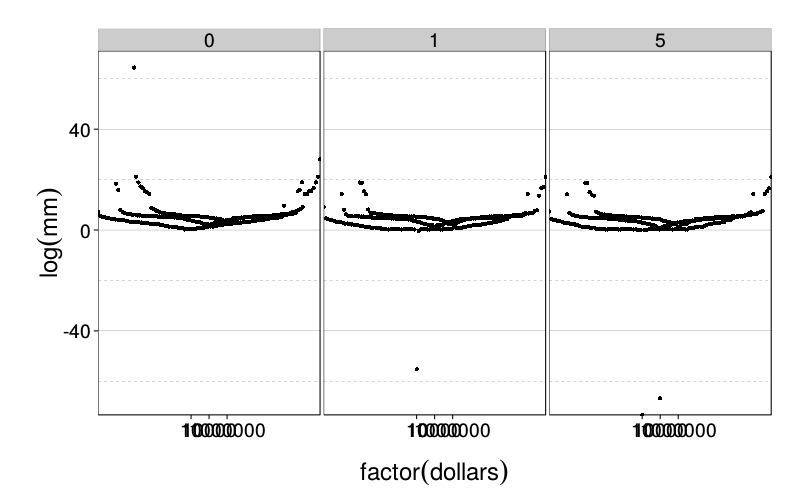
The discountinuous appearence of the distributions seem to arise from the choice of units. Here's a zoomed-in plot:
dodge(data = ss(ld.delay, log(mm) > 0 & log(mm) < 10),
factor(dollars), log(mm), years)
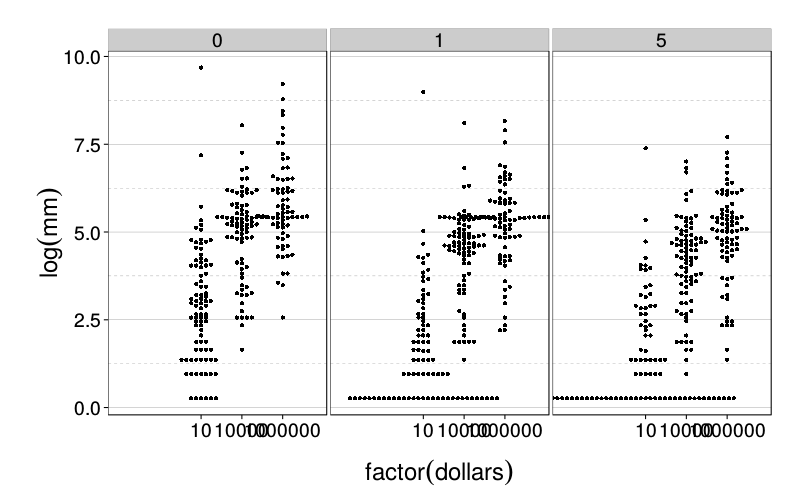
Between-subjects medians:
ggplot(ld.delay) +
stat_summary(aes(dollars, mm, color = ordered(years)),
fun.y = median, geom = "line") +
scale_x_log10(breaks = c(1e1, 1e4, 1e6)) +
scale_y_log10() +
coord_cartesian(ylim = c(1, 1000)) +
theme(panel.grid.minor = element_blank())
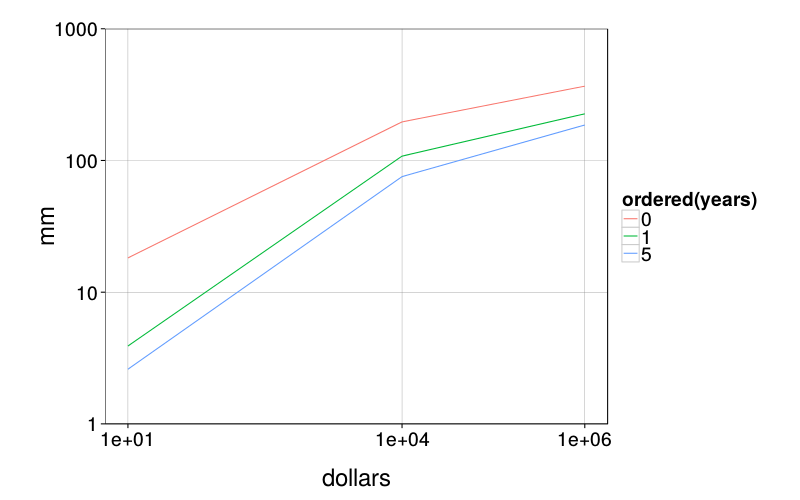
Now let's examine the significance of the interaction term in an appropriate statistical model.
model = lme(mm ~ dollars * years, random = ~1|s, data =
transform(ld.delay,
dollars = scale(log(dollars), scale = F),
years = scale(years, scale = F),
mm = log(pmax(1e-30, mm))))
rd(summary(model)$tTable[,"p-value"])
| value | |
|---|---|
| (Intercept) | 0.000 |
| dollars | 0.000 |
| years | 0.000 |
| dollars:years | 0.972 |
How about if we try the model with ranked millimeters?
model = lme(mm ~ dollars * years, random = ~1|s, data =
transform(ld.delay,
dollars = scale(log(dollars), scale = F),
years = scale(years, scale = F),
mm = rank(mm)))
rd(summary(model)$tTable[,"p-value"])
| value | |
|---|---|
| (Intercept) | 0.000 |
| dollars | 0.000 |
| years | 0.000 |
| dollars:years | 0.954 |
Still non-significant.
d = ss(dcast(
ss(ld.delay,
years %in% c(0, 1) & dollars %in% c(1e1, 1e4, 1e6),
select = -trial),
s ~ dollars + years,
value.var = "mm"),
`10_0` > `10_1` &
`1000000_0` > `1000000_1` &
`1000000_0` > `10_0` &
`1000000_1` > `10_1`)
ratios = with(d,
(log(`10_0`) - log(`10_1`)) /
(log(`1000000_0`) - log(`1000000_1`)))
nrow(d)
| value | |
|---|---|
| 61 |
table(ratios > 1)
| count | |
|---|---|
| FALSE | 13 |
| TRUE | 48 |
round(d = 5, t.test(log(ratios), mu = 0)$p.value)
| value | |
|---|---|
| 0.00027 |
Significant (and in the right direction).
With the more extreme delay (5 years):
d = ss(dcast(
ss(ld.delay,
years %in% c(0, 5) & dollars %in% c(1e1, 1e4, 1e6),
select = -trial),
s ~ dollars + years,
value.var = "mm"),
`10_0` > `10_5` &
`1000000_0` > `1000000_5` &
`1000000_0` > `10_0` &
`1000000_5` > `10_5`)
logratios = with(d,
log(log(`10_0`) - log(`10_5`)) -
log((log(`1000000_0`) - log(`1000000_5`))))
nrow(d)
| value | |
|---|---|
| 68 |
table(logratios > 0)
| count | |
|---|---|
| FALSE | 21 |
| TRUE | 47 |
round(d = 5, t.test(pmin(10, logratios), mu = 0)$p.value)
| value | |
|---|---|
| 0.00024 |
Also significant.
Probability
c("Sample size" = nlevels(ld.risk$s))
| value | |
|---|---|
| Sample size | 53 |
ggplot(ld.risk) +
stat_summary(aes(dollars, mm, color = ordered(prob)),
fun.y = median, geom = "line") +
scale_x_log10(breaks = c(1e1, 1e4, 1e6)) +
scale_y_log10() +
coord_cartesian(ylim = c(1, 1000)) +
theme(panel.grid.minor = element_blank())
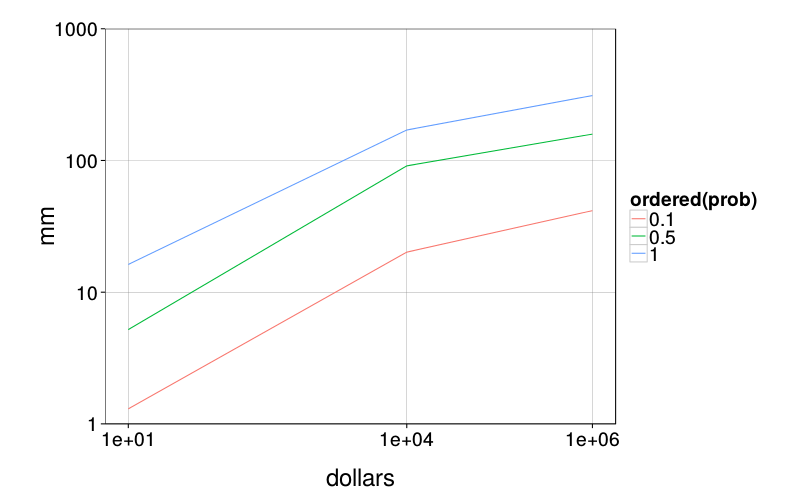
d = ss(dcast(
ss(ld.risk,
prob %in% c(1, .5) & dollars %in% c(1e1, 1e4, 1e6),
select = -trial),
s ~ dollars + prob,
value.var = "mm"),
`10_1` > `10_0.5` &
`1000000_1` > `1000000_0.5` &
`1000000_1` > `10_1` &
`1000000_0.5` > `10_0.5`)
ratios = with(d,
(log(`10_1`) - log(`10_0.5`)) /
(log(`1000000_1`) - log(`1000000_0.5`)))
nrow(d)
| value | |
|---|---|
| 40 |
table(ratios > 1)
| count | |
|---|---|
| FALSE | 19 |
| TRUE | 21 |
rd(t.test(log(ratios), mu = 0)$p.value)
| value | |
|---|---|
| 0.533 |
With the more extreme probability (.1):
d = ss(dcast(
ss(ld.risk,
prob %in% c(1, .1) & dollars %in% c(1e1, 1e4, 1e6),
select = -trial),
s ~ dollars + prob,
value.var = "mm"),
`10_1` > `10_0.1` &
`1000000_1` > `1000000_0.1` &
`1000000_1` > `10_1` &
`1000000_0.1` > `10_0.1`)
ratios = with(d,
(log(`10_1`) - log(`10_0.1`)) /
(log(`1000000_1`) - log(`1000000_0.1`)))
nrow(d)
| value | |
|---|---|
| 42 |
table(ratios > 1)
| count | |
|---|---|
| FALSE | 28 |
| TRUE | 14 |
rd(t.test(log(ratios), mu = 0)$p.value)
| value | |
|---|---|
| 0.248 |
DMV function slopes
median.slopes = function(d) {names(d)[length(names(d)) - 1] = "trailer" d = ordf(d, s, dollars, trailer) d1 = ss(d, dollars == 10) d2 = ss(d, dollars == 1e4) d3 = ss(d, dollars == 1e6) do.call(rbind, lapply(sort(unique(d$trailer)), function(the.trailer) {d1t = ss(d1, trailer == the.trailer) d2t = ss(d2, trailer == the.trailer) d3t = ss(d3, trailer == the.trailer) slopes12 = (log(d2t$mm) - log(d1t$mm)) / (log(d2t$dollars) - log(d1t$dollars)); slopes23 = (log(d3t$mm) - log(d2t$mm)) / (log(d3t$dollars) - log(d2t$dollars)); data.frame(t = the.trailer, "1to2" = round(d = 3, median(slopes12)), "3to4" = round(d = 3, median(slopes23)))}))}
Below, the t column has the delay or probability and the next two columns have the slopes from $10 and $10k and $10k to $1M. These are medians of the slopes for individuals, but comparisons between cells would of course be between-subjects comparisons.
median.slopes(ld.delay)
| t | X1to2 | X3to4 | |
|---|---|---|---|
| 1 | 0 | 0.298 | 0.199 |
| 2 | 1 | 0.434 | 0.162 |
| 3 | 5 | 0.401 | 0.194 |
median.slopes(ld.risk)
| t | X1to2 | X3to4 | |
|---|---|---|---|
| 1 | 0.1 | 0.259 | 0.047 |
| 2 | 0.5 | 0.347 | 0.118 |
| 3 | 1.0 | 0.305 | 0.157 |
Slopes between across-subjects medians
logmm = with(ss(ld.delay, years == 0),
tapply(log(mm), dollars, median))
rd(c(
slope12 = num((logmm[2] - logmm[1]) / (log(1e4) - log(10))),
slope23 = num((logmm[3] - logmm[2]) / (log(1e6) - log(1e4))),
slope13 = num((logmm[3] - logmm[1]) / (log(1e6) - log(10))),
b = num(coef(lm(y ~ x, data.frame(x = log(c(10, 1e4, 1e6)), y = num(logmm))))["x"])))
| value | |
|---|---|
| slope12 | 0.344 |
| slope23 | 0.136 |
| slope13 | 0.261 |
| b | 0.267 |
Here slope12 is the slope of the line from $10 to $10k, slope23 is the the slope of the line from $10k to $1M, and slope13 is the slope of the line from $10 to $1M. b is the slope of the regression line for all three points.
Delay graph redo
medians.plot = function(sb, df, colname, label, point.size = 8, font.size = 14) {colnames(df)[colnames(df) == colname] = "x" d = data.frame(do.call(cbind, aggregate(mm ~ dollars + x, ss(df, s %in% row.names(sb)), function(v) quantile(v, c(.4, .5, .6))))) ggplot(d, aes( dollars * (1 + num(factor(x))/10 - .2), X50., ymin = X40., ymax = X60.)) + geom_line(aes(linetype = ordered(x))) + geom_point(size = point.size) + geom_linerange() + scale_x_log10(name = "amount (dollars)", breaks = c(1e1, 1e4, 1e6), labels = c("10", "10,000", "1 million")) + scale_y_log10(name = "happiness (mm)") + guides(linetype = guide_legend(title = label)) + coord_cartesian(ylim = c(1, 1000)) + theme_bw(base_size = font.size) + theme( panel.grid.minor = element_blank(), panel.grid.major = element_blank(), legend.position = c(1, 0), legend.justification = c(1, 0), legend.background = element_rect(colour = "black", fill = "white"), panel.border = element_blank(), axis.line = element_line(color = "black"))} medians.plot(sb, ld.delay, "years", "Delay (years)")
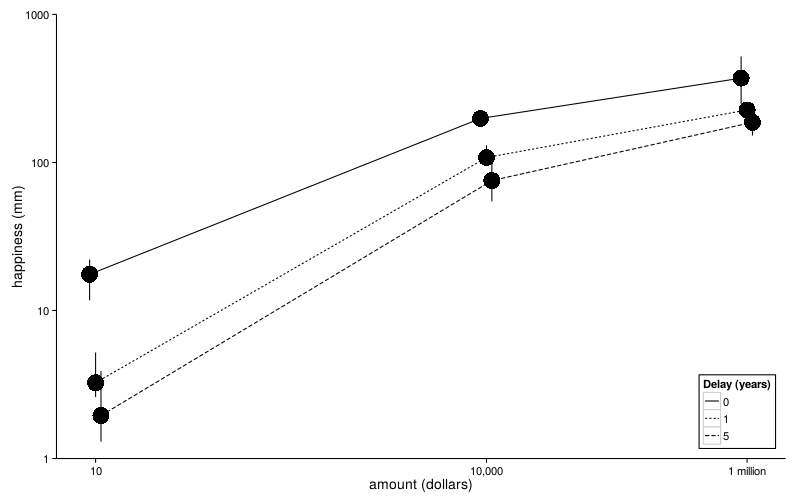
For generating the paper figure: cairo_ps("/tmp/out.eps", width = 6.5, height = 5); medians.plot(sb, ld.delay, "years", "Delay (years)", point.size = 2, font.size = 14); dev.off();